![]()
![]()
![]()
Use LEFT and RIGHT arrow keys to navigate between flashcards;
Use UP and DOWN arrow keys to flip the card;
H to show hint;
A reads text to speech;
51 Cards in this Set
- Front
- Back
|
What is the origin of the posterior pituitary, what is it made up of, where are the cell bodies found and what hormones does it secrete?
|

It is neural tissue descended from the hypothalamus.
Made up of axons and glial-like cells called Pituicytes The cell bodies of these axons are found in the Supraoptic and Paraventricular nuclei in the Hypothalamus The posterior pituitary secretes Oxytocin and ADH (Vasopressin) |
|
|
List the contents of the cavernous sinus.
|

|
|
|
What are ADH and Oxytocin, how are they formed, what do they do, and what happens when they accumulate?
|
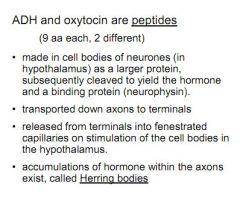
|
|
|
Describe the pars distalis, the cells types contained within and give their secretory products.
|

Pars Distalis contains cords of cuboidal/polygonal epithelial
secretory cells clustered around large fenestrated sinusoids |
|
|
What is the cellular makeup and or secretions of the pars intermedia and tuberalis?
|

|
|
|
How are the secretions of the anterior pituitary controlled by the hypothalamus?
|
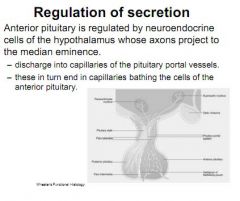
|
|
|
Describe the organisation of the thyroid gland, where it lies in the neck and how/why it might be attached to the hyoid bone. State it's cellular organisation, and describe the method for it's secretion of Thyroxine and Iodothyronine.
|
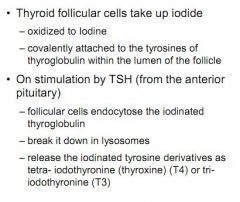
Two pear shaped lobes sit either side of the midline at or between the 2nd and 4th tracheal rings.
Embryologically derived caudal to the tongue, a remnant of the thyroglossal duct may still connect the thyroid to the hyoid bone. Inside it is composed of follicles containing colloid - an accumulation of thyroglobulin. This is secreted and bound to iodine. Stimulation by TSH causes the follicles to endocytose the iodinated thyroglobulin, which is then broken down to T4 - Thyroxine and T3 Iodothyronine |
|
|
What cells are found outside of the follicles within the thyroid and what do they do?
|
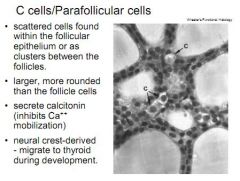
|
|
|
Describe the size, shape and location of the parathyroid glands. Give their cellular make up and explain their secretions.
|

The parathyroid glands are pea sized and lie posterior to the lateral border of the lobes of the thyroid.
They are made up of chief cells, lying in irregular cords around blood vessels and secreting PTH - which mobilises Ca2+ They also contain Eosinophilic cells which have an unknown function. |
|
|
Describe the Islets of Langervole, and give their cell make up and secretions.
|

|
|
|
The gut contains many neuroendocrine cells. What do they secrete and what role can they play in the decarboxylation of amines.
|
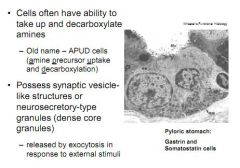
Diffuse throughout the gut system, secrete amines and peptides (gastrin, CCK, secretin, 5-HT), enteroglucagon)
Can often take up and decarboxylate amines |
|
|
Describe the synthesis and release of the major classes of hormones.
|
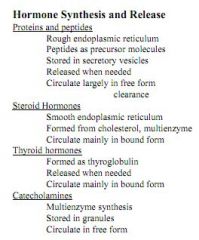
|
|
|
Describe the reaction by which adrenalin is produced from tyrosine by multi-enzymes.
|
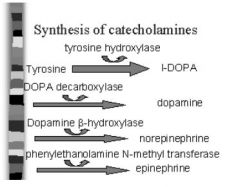
|
|
|
Contrast the production of protein hormones with steroid hormones
|
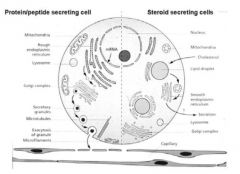
|
|
|
Outline the techniques which are used to estimate hormone concentrations in blood samples
|
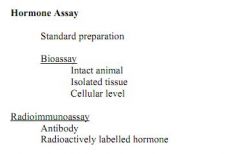
Also ELISA - new gold standard
Unknown amount of antigen is fixed, and an antibody added. Binding generates a confirmational change (colour for example) allowing accurate quantification. |
|
|
Give reasons for hyper- and hypofunction
|
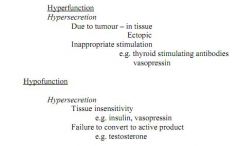
|
|
|
Give 6 hormones produced by the anterior pituitary with their site of action
|
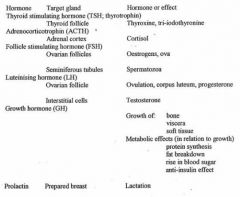
|
|
|
List 5 stimulatory hormones produced by the hypothalamus and 2 inhibitory ones, with their actions.
|
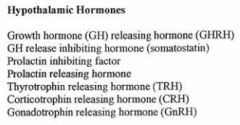
|
|
|
Explain four different ways in which hypothalamic and anterior pituitary hormones are released and give examples.
|
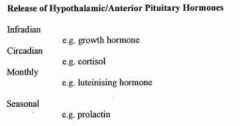
|
|
|
Secretion of hormones from the anterior pituitary is episodic, what drugs could be used to stimulate or inhibit secretion?
|

|
|
|
Give the composition of growth hormone, hormones which stimulate and inhibit its secretion, its mode of action and conditions associated with hyper- and hyposecretion
|
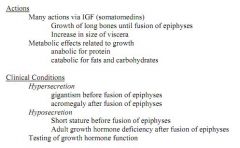
Growth hormone is 191 amino acid compound secreted by the anterior pituitary
Stimulation for secretion is by GHRH. Inhibition is by Somatostatin and Insulin Like Growth Factor Also stimulated by hypoglycaemia, post-prandial fall in glucose levels, vigorous exercise, deep sleep, physical and psychological stress Actions include the growth of long bones before the fusion of the epiphyses, and growth of viscera. In later life GH has an anabolic effect on protein (build up) and a catabolic effect on fat and carbohydrates (break down) Hypersecretion in the young leads to Gigantism. After the fusion of the epiphyses it leads to Acromegaly. Hyposecretion causes a short stature in the young, or a deficiency in adults. |
|
|
Give the composition of prolactin, the hormones which stimulate and inhibit its secretion, and its mode of action
|
Prolactin is made of 99 amino acids, and is secreted during pregnancy and lactation.
It is stimulated by TRH and inhibited by dopamine It acts to aid the development of additional breast tissue in pregnancy, and the production of milk post-childbirth |
|
|
Give the composition of ACTH, hormones which stimulate and inhibit its secretion and its mode of action
|

39 amino acids
Secretion stimulated by CRH, inhibited by itself Acts on the Adrenal Cortex to stimulate release of cortisol and aldoterone. |
|
|
Describe the composition of the neurohypophyseal hormones secreted by the posterior pituitary. Describe their site of action and give examples of conditions of hyper- and hyposecretion
|
Produced in the supraoptic and paraventricular nuclei. 9AAs long.
ADH is secreted in response to low blood volume, and stimulates the expression of aquaporins in the DCT to increase uptake of H2O Oxytocin is secreted before childbirth and stimulates the contraction of the uterus. Post-parturition, Oxytocin plays a role in the ejection of milk from the breast Hypersecretion of ADH causes a syndrome (SIADH) Hyposecretion of ADH causes Diabetes Insipidus |
|

Whats going on in these three slides. And what are 'I'?
|
The first is a normal thyroid, with cuboidal follicular cells surrounding collections of colloid.
In the middle slide, the colloid collections are bigger, and there are smaller and fewer follicle cells (indicating hypothyroidism) In the righthand slide, there is no colloid, and lots of follicular cells, indicating hyperthyroidism. 'I' are calcitonin secreting 'c-cells' |
|
|
Describe the process of synthesis of thyroxine (T4) and triiodothyronine (T3)
|
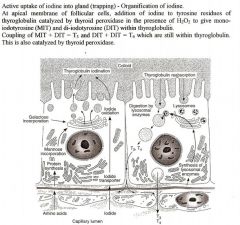
|
|
|
Describe the process of secretion and the regulation of secretion of T4 and T3.
|
Stimulation is from the hypothalamus secretion of TRH (Thyrotropin Releasing Hormone) - this also stimulates Prolactin release
TRH causes the anterior pituitary to secrete TSH. T3 feeds back on the anterior pituitary and the hypothalamus to inhibit further release of TSH and TRH The thyroid responds to secretion by taking up lysosomes of colloid, which is broken down in the follicular cells to release T4 and T3 (DIT and MIT are also produced by these are recycled) T4 is 20 times more abundant than T3 which is the more active compound. T4 half life is 7 days, T3 is 1 day. Most T4 and T3 circulates bound to plasma proteins. Only 0.04% of T4 and 0.4% of T3 is free and active in the circulation. |
|
|
Describe the mechanism of action of T3 and T4 by receptor binding and the metabolic effects of the hormones.
|
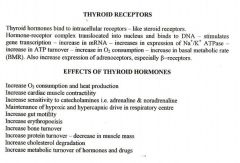
|
|
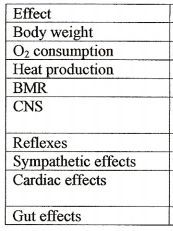
List how hyper- or hypothyroidism would affect these body functions.
|

|
|
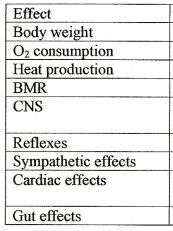
List how hyper- or hypothyroidism would affect these body functions.
|

|
|
|
Give four causes of hypothyroidism and indicate treatment options.
|
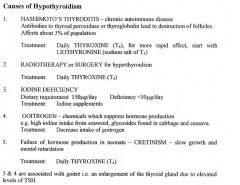
Treat with thyroxine
|
|
|
Give causes for hyperthyroidism, plus possible treatments
|
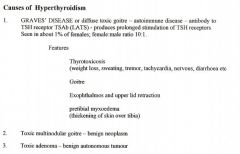
TReat with radioiodine, B-blockers for cardiac symptoms, thyroid peroxidase inhibitors, maybe some resection.
|
|
|
Describe the biosynthesis of catecholamines from tyrosine, and give the rate limiting step
|

Rate limiting step is the conversion of tyrosine to DOPA by the enzyme Tyrosine Hydroxylase
|
|
|
Describe the mechanism for the regulation of secretion of cortisol and aldosterone.
|
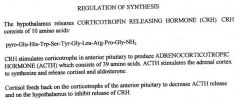
|
|
|
Describe the process and site of production of steroid hormones.
|
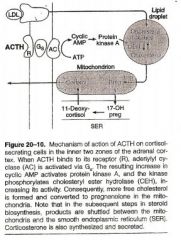
Cholesterol is the basis of all steroid hormones.
ACTH binds a G-protein receptor, causing a rise in intracellular cAMP and activating Protein Kinase A. This activates 20,22 Hydroxylase, the first enzyme in the synthesis of steroids (and the rate limiting step) and also Cholesterol Ester Hydrolase - this leads to an abudance of free cholesterol, which is used to make Pregnenolone and then deoxycortisol in Mitochondria |
|
|
Describe the method of action of corticosteroids in a target cell.
|

Steroid enters cell by diffusion (lipophilic)
This causes the dissociation of Heat Shock Protein (hsp90) from the receptor in the cytosol, allowing activation by the steroid. Receptor plus steroid form a dimer and enter nucleus. Bind Hormone Responsive Element on DNA, causing increased mRNA production and protein synthesis |
|
|
Describe the main effects of corticosteroids on the body.
|
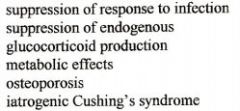
1) Metabolic
Reduces glucose uptake and use, increases gluconeogenesis leading to higher blood glucose Also reduces protein synthesis and increases catabolism of proteins, leading to muscle wasting. Reduces Ca2+ absorption in the gut, and increases excretion of Ca2+ in the kidneys, causing thin bones and osteoporosis. 2) Affects the balance of H2O and electrolytes 3) Anti-inflammatory Inhibits COX-2, cytokines, complement, Nitric Oxide and histamines and IgG. Result is reduced inflammation but poor wound healing and repair later on 4) Immunesuppression |
|
|
Describe the symptoms of Cushings.
|
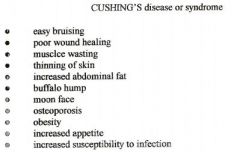
|
|
|
Addisons. Give it to me.
|

|
|
|
Describe the production of androgens by the adrenal glands
|

The adrenals secrete weak androgens. In a pre-menopausal woman they secrete 50% of androstenedione, which is converted to oestrone and testosterone in adipose sites.
Excess secretion causes hirsuitism Post-menopase, the role of the adrenals in oestrone become more important, as the ovary ceases to be a main supplier of hormones. Due to the role of adipose tissue, the bigger women have more. |
|
|
Try and vageuly recall the routes for production of steroids from cholesterol
|
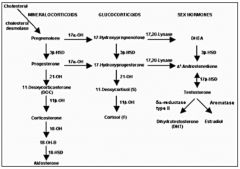
|
|
|
List some factors which can cause primary or secondary adrenal failure
|
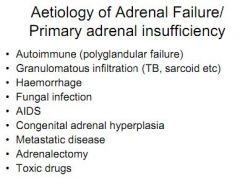
Secondary can be caused by coming off steroid treatments.
|
|
|
Give some symptoms of Addisons?
|
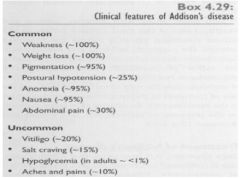
|
|
|
How would you diagnose Addisons?
|

|
|
|
Contrast symptoms of Addisons and Cushings
|
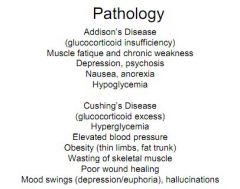
|
|
|
What is phaeochromocytoma?
|

Adrenal Medulla tumour
|
|
|
What is Conn's syndrome and how would you test for it?
|
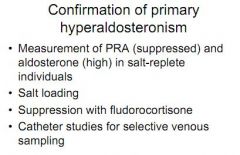
Primary Hyperaldosteronism, diagnosed by measuring PRA, looking at salt loading
|
|
|
Describe how a condition is classified as autoimmune.
|
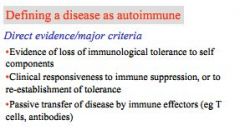
|
|
|
Describe the pathway for automimmunity in Graves and Hashimotos Thyroiditis, and classify them as either antibody or T-cell mediated.
|
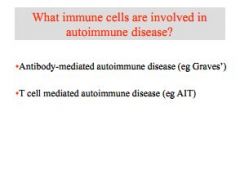
APC presents MHC class 2 to naive t-cell, differentiates to Th2 activates B-cells, plasma cells produce autoantibodies.
In Graves these are against the Thyroid Receptors. In Hashimotos they are againsts the thyrocytes themselves. Graves in antibody mediated, Hashimotos is T-cell mediated. |
|
|
Explain how thyroid status can be evaluated using tests for T4 and TSH levels.
|
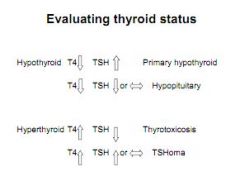
|
|
|
Explain the possible visual defect caused by a pituitary tumour.
|

|

